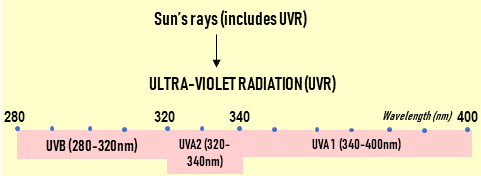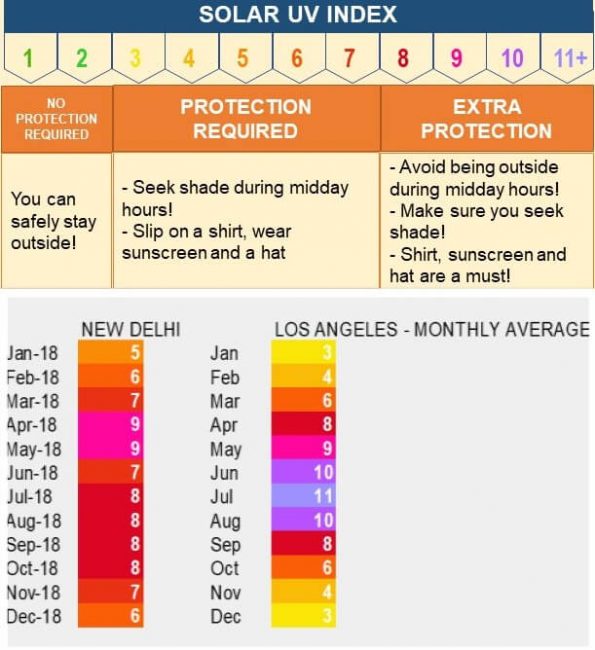My sister pointed out that I may be too tunnel visioned in my approach to sun protection – I assume everyone is on the same page as I am. She has a point. We all heard others say, “skin cancer is a rarity in South Asia – why would anyone need sun protection?” Also, “you can never see the sun in many cities, so why sun protection?” Both of these are “myths.”
1) What is Ultra Violet Radiation (UVR)?
Sunlight comprises of Ultraviolet radiation (UVR), visible and infrared radiations.

Stratospheric ozone absorbs most UVR that is of wavelength < 295nm and sunlight reaching earth contains:
- UVB (5%-10% of total UVR)
- UVA (90%-95% of total UVR)
- UVA I forms 75% of this
- UVA/UVB cut-off is 320nm and this is widely used in photodermatology.
2) What are the risks associated with over-exposure to UVA and UVB?
Sun burn (or inflammation of the skin) resulting from reddening of the skin (erythema) is mainly caused by UVB. UVB is also mainly responsible for skin cancer: its recognized as a carcinogen.
We now know, that UVA also contributes to risk of skin cancer, but UVA is primarily responsible for premature ageing (or photoaging), through generation of Reactive Oxygen Species (ROS), which essentially causes the breakdown of collagen in our skin. Collagen is what gives skin its structure and resilience. Premature ageing is characterised by hyperpigmentation, wrinkle and loss of skin elasticity and so on.
UV s the main cause of hyperpigmentation – any dermatologist worth their dime will tell you that.
Both UVA and UVB negatively impact the body’s immune system. Its also possible for the skin on your eyes to burn – causing inflammation and on a long-term basis, cataracts, which globally is a major source of blindness.
3) Why do you need sunscreen?
This is straight from the Skin Cancer Foundation’s website. Regular daily use of an SPF 15 or higher SPF sunscreen:
- Reduces the risk of developing skin cancer by 40% -50% depending on the type of skin cancer
- Reduces damage relating to photo-ageing. This is in comparison to people who do not use sunscreen.
Both claims are now supported by an ample body of scientific evidence.
Myth 1: If you don’t feel the hot rays of the sun, you won’t get sunburnt.
Sunburn is caused by UVR which cannot be felt. The heating effect is caused by the sun’s infrared radiation and not by UVR.
4) How do I know when to use sun protection?
Most of the guidance on when to use sun protection addresses UVB exposure, as it was written when everyone (scientists, physicians, consumers) were just concerned with skin cancer. BUT, NOW we know that skin must be protected against BOTH UVA and UVB – so we need to interpret these guidelines based on our current understanding of UVA and UVB.
Our starting point is the intensity of UVR exposure and skin type.
4a) Intensity of UVR
This depends on:
- Geography: UVR is strongest closest to the equator, because the sun is directly over the equator and has a short distance to travel.
- Altitude: Higher altitudes have greater UVR exposure as the atmosphere is much thinner and so more UVR reaches the earth’s surface.
- Time of the year: Summer’s see more UVR reaching the earth’s surface as during the summer, the earth is closer to the sun.
- Time of the day: UVR is most intense at mid-day when the sun is directly above us and UVR has the shortest distance to travel.
- Weather conditions: UVR penetrates cloud cover (see below).
- Reflection: Surfaces such as snow, sand, water and grass reflect UVR, which hits us if we are not wearing adequate sun protection.
Myth 2: the sun is not shining as its cloudy and therefore I cannot get sun damage.
Sun damage is caused by UVR AND not temperature. An overcast day (especially in the summer) can have similar UV levels to a sunny day, as (eg) 80% of solar UVR can penetrate light cloud cover. Haze in the atmosphere can even increase UVR exposure.
Myth 3: I spend a lot of my office hours indoors and therefore will not get sun damage
UVB cannot penetrate glass, but UVA (which causes premature ageing) can penetrate glass, irrespective of whether its a car/train/office window.
4b) The Solar UV Index (UVI)
UVI in its simplest terms is a measurement of the intensity of UVR at a given moment. The UVI number measures erythemal UVR and therefore, focuses on avoiding sunburn. Most countries, make publicly available a Solar UV Index, which is a single digit that’s used to give sun protection guidance. The UVI is generally available in weather forecasts and online. I have looked up monthly averages for Los Angeles and New Delhi.

Essentially, if you live in New Delhi OR Los Angeles, you should wake up and wear sun protection (including SPF 30+), every single day of the year. And then reapply and repeat.
Note: Sun protection is not JUST sunscreen – although for a skincare blog, it kind of is. Sun protection includes the shade (an umbrella), sunglasses (polarised eyewear) and protective clothing (nylon, cotton and tightly woven fabrics) .
Myth 4: I have dark skin and therefore, I don’t need sun protection.
In the 1970s, Thomas Fitzpatrick defined skin phototype definitions based on the first 30-45 minutes of sun exposure after a winter season of no sun exposure.

A lot of earlier guidance (WHO in 2002), looked at the Fitzpatrick scale and directed countries to give sun protection guidance mainly to Type I and Type II skin types, clearly indicating that skin cancer is at the forefront of everyone’s mind. However, UVA (which causes premature ageing) applies to all skin types.
5) What protection does dark skin need, if any?
All of us have skin pigment melanin in our bodies – its what gives our eyes, skin and hair colour. Melanin is of two types: eumelanin (dark brown pigment) and pheomelanin (yellow/red pigment).
Dark skin has more eumelanin than fair skin and its thought, that eumelanin gives dark skin better protection against UV than fair skin. Gloster and Neal indicate that Black skin (Type VI) is 2x as effective as compared to white skin in inhibiting UVB from penetrating the skin. Black skin allows about 7.4% of UVB and 18% of UVA to penetrate BUT 24% of UVB and 55% of UVA passes through white skin.
Finally, the study by Brenner et al, referred to below demonstrate that EVEN THE DARKEST SKIN TYPE DOES INCUR SIGNIFICANT DNA DAMAGE when exposed to radiation.
There is no such thing as totally UV-resistant human skin.
Michaela Brenner and Vincent J. Hearing The Protective Role of Melanin Against UV Damage in Human Skin
Photochemistry and Photobiology, 2008, 84: 539–549
Therefore, EVERYONE needs sun-protection.
I would love to hear what you think, so please email me or leave a comment.
See also: Guide to Buying Sun Protection, Chemicals to Avoid – Benzophenone-3,Sun protection – products that make the cut,
Sources and uses:
- Angela Tewari, Mette M. L. Grage, Graham I. Harrison, Robert Sarkanya and Antony R. Younga, UVA1 is skin deep: molecular and clinical implications, Photochem. Photobiol. Sci., 2013, 12, 95
- Michaela Brenner and Vincent J. Hearing, The Protective Role of Melanin Against UV Damage in Human Skin Photochemistry and Photobiology, 2008, 84: 539–549
- Gloster, H.M., Jr amd K. Neal (2006) Skin cancer in skin of color. J. Am. Acad. Dermatol. 55, 741-760
- Halder, R. M. and S. Bridgeman-Shah (1995) Skin cancer in African Americans. Cancer 75, 667-673
- Parrish, J. A., K. F. Jaenicke and R. R. Anderson (1982) Erythema and melanogenesis action spectra of normal human skin. Photochem. Photobiol. 36, 187–191.
- Recommendations of 22 September 2006 on the efficacy of sunscreen products and the claims made relating thereto (2006/647/EC). Official Journal of the European Union.
- Recommendations from the European Commission. Federal Office of Public Health. Recommendations from the European Commission; 2009.
- The Sun and the skin: evidence-based photoprotection and sunscreen guidelines. Dermatological Nursing 2016, Vol 15, No 2 (suppl)
- Robyn M. Lucas, Rachel E. Neale, Sasha Madronich and Richard L. McKenzie Are current guidelines for sun protection optimal for health? Exploring the evidence Photochem. Photobiol. Sci., 2018, 17, 1956
- https://www.safeworkaustralia.gov.au/system/files/documents/1702/guide-exposure-solar-ultraviolet-radiation.pdf
- https://www.weather-us.com/en/california-usa/los-angeles-climate
- https://www.worldweatheronline.com/new-delhi-weather-averages/delhi/in.aspx
- https://www.arpansa.gov.au/our-services/testing-and-calibration/sun-protection-buyers-guide
- https://www.cancercouncilshop.org.au/about/information/faqs
- https://www.who.int/uv/publications/globalinde
- https://ntp.niehs.nih.gov/ntp/roc/content/listed_substances_508.pdf
- https://www.federalregister.gov/documents/2019/02/26/2019-03019/sunscreen-drug-products-for-over-the-counter-human-use